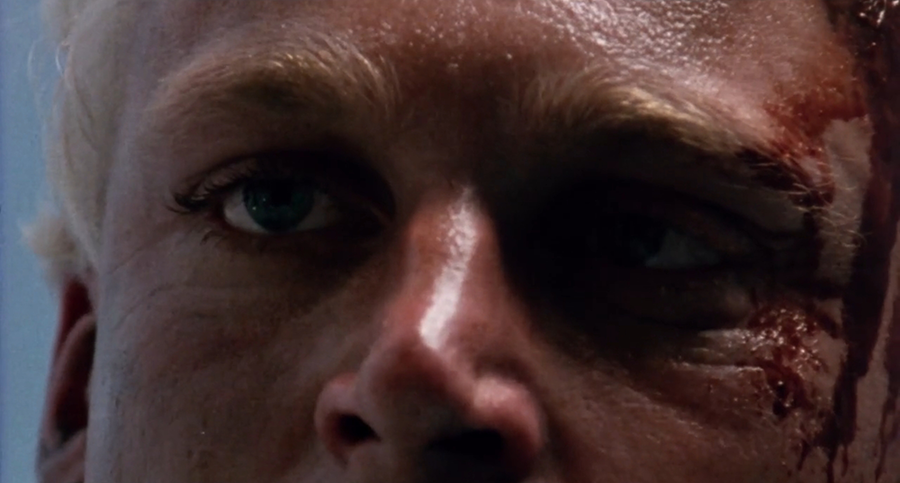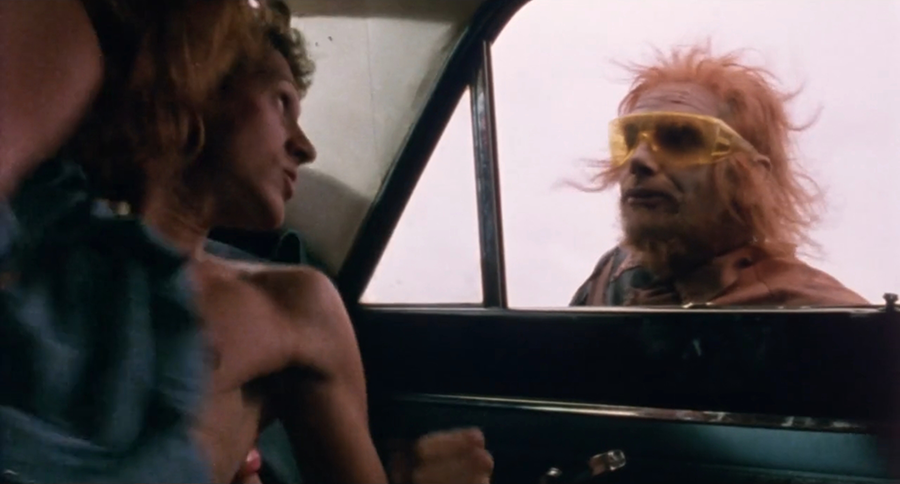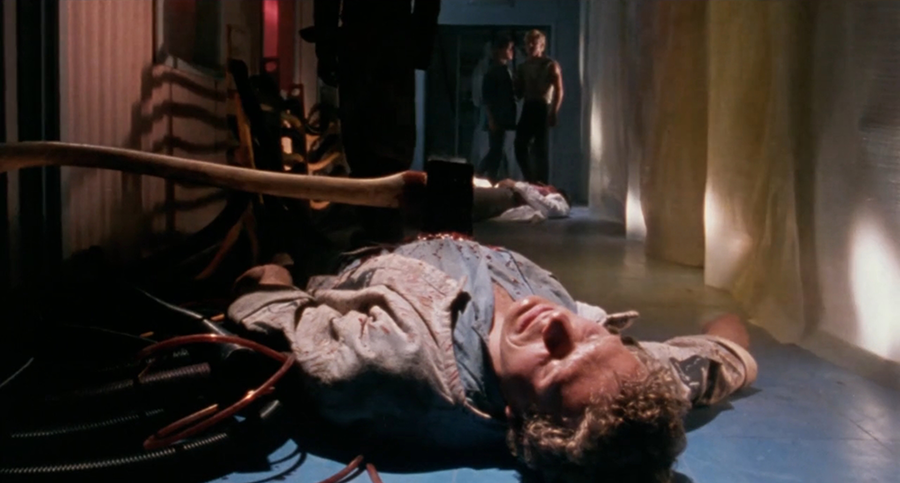DEATH WARMED UP
Directed by David Blyth. 1984. New Zealand.

“The story doesn’t make sense” is perhaps the most common piece of criticism I’ve seen leveled at David Blyth’s 1984 slice of Kiwi horror, DEATH WARMED UP. Having not seen the film before today, I was curious to find out just how incomprehensible it really is. Were these critics being hyperbolic? Was it that the narrative was so schizophrenic and illogical that it was beyond comprehension? Or was it just a case of events lacking any context? What kind of clusterfuck was I in for, and would I even be able to explain it adequately enough for it to be understood?
Well, I’ve watched it and I’m ready to give it my all. Let's see just how incomprehensible it really is.
Creepy Dr. Howell injects a young man named Michael with some sort of serum before subjecting him to a nice bout of mind control. Upon returning to his home, Michael, still in a severely altered state, shotguns both his mother and father to death (his father, incidentally, was both a co-worker and rival to Dr. Howell). As a result, Michael is institutionalized for seven years. Upon his release, Michael, his girlfriend Sandy, and their two friends, Lucas and Jeannie, board a ferry to an isolated island that serves as the base of operations for Dr. Howell’s medical research company, Trans Cranial Applications. Aboard the ferry, Michael and Co. make quick enemies of two weirdos, one of whom is developing a throbbing disfigurement on the top of his head.
Once reaching the island, Michael and Co. hit the beach before exploring some underground World War II tunnels. The two ferry weirdos track them down and harass them on motorcycles, seriously injuring Jeannie in the process. In retaliation, Michael impales one of them on a piece of rebar. Escaping back to their car, Michael’s friends beg him to take Jeannie to the nearby hospital, but Michael, knowing full well that Dr. Howell’s hospital is the last place you’d want to go for help, protests against it. As they bicker and argue over how not to let their friend bleed to death, the ferry weirdos reach Dr. Howell’s hospital. The fatally wounded weirdo’s head finally explodes, and the other, not appreciating Dr. Howell’s callous attitude, decides to unleash the doctor’s hyper-aggressive, zombie-like patients, sending them on a collision course with Michael and his friends at a local pub.
After surviving an all-out assault by the escaped patients, Michael and Co. are quickly rounded up by Dr. Howell’s staff and transported back to the hospital. Unfortunately, things are no better there. Patients are running loose, killing everyone in sight. Jeannie accidentally sets herself on fire trying to stave off a lunatic, leaving Sandy and Lucas to fend for themselves. Michael, on the other hand, is taken directly to the man he’s been wanting to kill for the past seven years, the asshole Doctor himself.
There. That wasn’t so hard, was it? A nice and logical progression of events. Too bad none of it makes any fucking sense.

I could fill the rest of this review with unanswered questions. For starters, what exactly is Dr. Howell doing? We see him doing brain surgery a couple of times during the movie, but why? He used mind control drugs on Michael all those years ago. Is that not a thing anymore? What is the “application” in Trans Cranial Applications? All we know is it’s causing some people’s heads to explode. The other people affected by Dr. Howell’s procedures turn into mindless, violent zombies. Or they don’t, I guess.
The inciting incident in this film comes when Lucas pisses on the van owned by the ferry weirdos. One of the two weirdos is obviously suffering from side effects caused by Dr. Howell’s treatment. We can assume that’s why they’re going to the island. But the other weirdo is perfectly fine. We can assume he, too, was treated by Dr. Howell because he knows exactly where to go to let the zombies out. I guess whether or not your head explodes or you become a zombie or you’re just a regular old asshole is a roll of the dice.
But this raises a whole other list of questions. What the fuck are the motivations for these characters? If the weirdos are suffering from side effects, why do they bother harassing our characters? I can’t imagine someone pissing on my van would matter more to me than my head potentially exploding. And is Michael heading to the island to kill Dr. Howell, or is it just a happy coincidence that he’s vacationing on the island where Dr. Howell lives? Seems odd that someone who was hypnotized into killing his parents by a mad scientist would voluntarily choose to come to an island apparently owned by that mad scientist just to putz around in some WWII tunnels. When he finally confronts the mad doctor, Michael tells him that he’s been waiting seven years for this, as if it’s been occupying his every thought. Just 20 minutes earlier, Michael was dry humping Sandy on the beach without a care in the world.
How do the escaped lunatics know where to find Michael and his friends? Why do their numbers appear to rise or fall depending on the set-piece? Why does no one seem concerned about the rampaging lunatics? Dr. Howell tells Michael that if he kills him, no one will be able to stop the hundreds of people he’s operated on. So are all “hundreds” of these people going nuts or having their heads explode? Was that part of the plan? Was creating murderous lunatics Dr. Howell's goal or just a side effect? Is the film now attempting to turn him into an anti-hero? Dr. Howell doesn’t seem to regret his experiments, so I guess not, but then why is he so concerned with the reprecussions of his experiments? I wish I knew what the hell the point of these experiments was. At one point, Dr. Howell pries what looks like a stone out of a patient’s brain. What was it? Why is this film so reluctant to tell me what is going on, and why isn't anyone acting like a relatable human being?

If this movie were made today, people would wonder if the real author was ChatGPT. It bears all the tell-tale signs of a properly constructed narrative. It has a three-act structure. The action rises and falls. Our characters go from reactive to proactive. Michael and Sandy have rudimentary character arcs. But the hows and whys feel disconnected from actual human experience or emotion. They feel positively alien, as if the character’s behaviors were being created by an algorithm trying to simulate human experience. Even within scenes, characters behave in odd ways. Sandy is comforting Jeannie in the backseat of the car after she got her skull split open by the ferry weirdos. “You’ll be just fine”, Sandy says to her friend before immediately screaming at Michael, “she’s gonna die if we don’t get her help!”.
Everything feels off and odd, as if the film were operating on some alien dream logic. Characters do not have personalities; they have emotional light switches that get turned on and off again throughout the film. The disconnect between my brain chemistry and the brain chemistry of the people on screen made everything feel like it was happening for reasons I could not comprehend, even if I was never at a loss for how I ended up where I was at any given moment. It wasn’t that the story made no sense. It was that the people in the story didn’t make sense. It was like listening to a paranoid schizophrenic in the throes of a delusion tell me about their trip to the grocery store. I know they really went there. I can see the bags and read the receipts. I just do not believe they were followed through the aisles by the Men in Black, and only made it out because the people on the cereal boxes started singing La Bamba loud enough to cause a distraction. The movie needed people who acted like thinking, rational agents. Instead, they are just pawns moving around the board according to rules written in some ancient eldritch language incomprehensible to human minds.